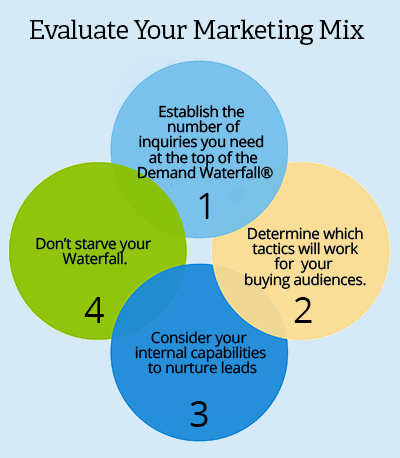Fix That Mix
- B2B organizations’ marketing mix selection for demand creation is often suboptimal
- Many organizations market to the wrong audiences, and insufficiently respond to and process new leads
- The marketing mix should be evaluated as part of the annual planning process and revisited at least quarterly
As a consulting director in the marketing practice at SiriusDecisions, I frequently have the opportunity to study our clients’ marketing mixes while assessing their demand creation programs. Data comes from clients’ marketing plans and campaign reports, as well as benchmarks from clients in our Demand Creation Strategies service that compare our clients to their peers.
 Time after time, we have found that marketing mix selection for demand creation is suboptimal. Organizations are either marketing to the wrong audiences, suffering from internal issues, insufficiently responding to and processing new leads, having problems with the volume of new leads or level of lead qualification required, or some combination of the above.
Time after time, we have found that marketing mix selection for demand creation is suboptimal. Organizations are either marketing to the wrong audiences, suffering from internal issues, insufficiently responding to and processing new leads, having problems with the volume of new leads or level of lead qualification required, or some combination of the above.
We suggest you evaluate your marketing mix as part of your annual planning process and revisit the mix at least quarterly. Here are some suggestions to get that mix just right:
- Establish the number of inquiries you need at the top of the Demand Waterfall® to meet your revenue objectives. Consider using reverse waterfall modeling, which starts with revenue goals and reverses the waterfall using average selling price and conversion rates at the various lead transition stages.
- Determine which tactics will work for your buying audiences. It does not make sense to market to people using tactics that they are not interested in or will not respond to. SiriusDecisions has run a comprehensive survey of B2B buyers, and established buyer profiles that include preferred tactics by buying stage and preferred asset types.
- Consider your internal capabilities to nurture leads, further qualify them, and engage your prospects. Do you have a marketing automation platform to nurture leads and monitor activity? Do you have a telequalification organization to further qualify leads? Is there reasonable load balancing between your marketing and sales teams such that each function is working on leads at the right time for its role? You can adjust your demand creation plan in the short term to match your internal capabilities. But in the long term, you’d better align your internal capabilities to meet market needs and support your organizational objectives.
- Don’t starve your Waterfall. For example, if you have an efficient marketing automation platform and an effective telequalification team – and you invest in content assets to create demand – look for every opportunity to create new leads that have a high probability of becoming qualified and result in closed deals. Don’t be stingy when considering the relatively small, incremental spend associated with content syndication, online advertising, paid keyword search, search engine optimization and other efficient methods if you already have the more expensive nurture and qualification infrastructure in place.
John Wanamaker, a department store merchant and pioneer in advertising, famously said, “Half the money I spend on advertising is wasted; the trouble is, I don’t know which half.”
Fortunately, with deep research about buyer behavior, modern digital marketing techniques and buyer’s journey mapping now available, your tactical marketing mix does not have to suffer that same fate. For additional help in diagnosing your marketing mix and optimizing your spend, consider SiriusDecisions Consulting.